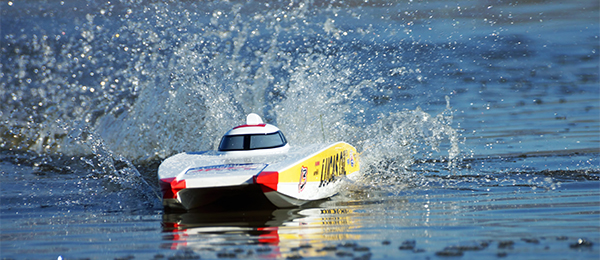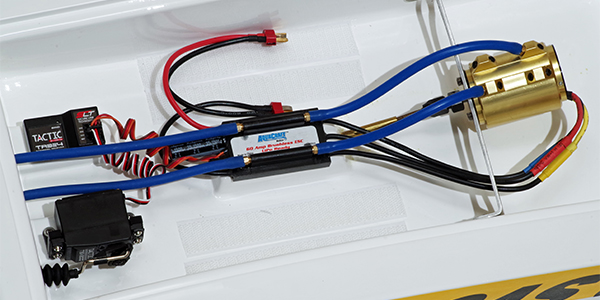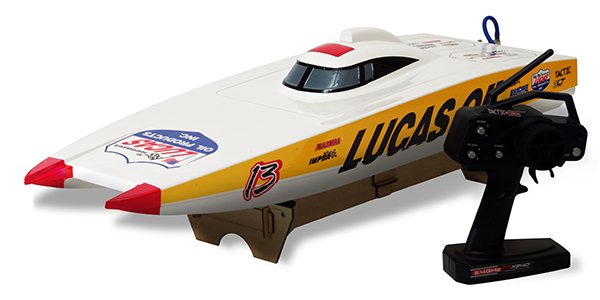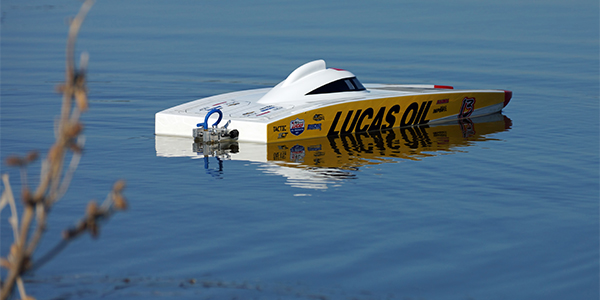AquaCraft Lucas Oil Brushless FE Catamaran

Written by Jon Barnes Read the entire review in the April 2014 issue of Model Aviation. This beauty stands out from other racers
A boat review for an aviation magazine? Oh come on, you say! Before you write the editor to voice your discontent, read on to see if I can convince you of the connection. Many pilots have discovered the thrill (and relaxation) of flying off of water. There is something so grand about taking to the air from a glassy, smooth, mirrorlike pond or lake. The time between flights is usually spent recharging flight batteries and kicking back, perhaps daydreaming a little about all things RC. Isn’t that what most people do when they are at the lake? If we are completely honest with ourselves, it is probably safe to say that even hardcore pilots have found their aircraft-based daydreams invaded by the occasional stray thought of owning an RC boat. A variety of boats are available, from toy grade all the way up to serious, high-performance, hobby-grade, fast-out-of-the-box boats. I’m here to discuss the latter.
First Impressions/Introduction
If the sheer size of the box that a boat comes in is any indication, the AquaCraft Lucas Oil Catamaran is one serious boat! Available as ready-to-run (RTR) at $399.99 or receiver-ready (Rx-R) for $339.99, this catamaran also bears the GrimRacer moniker and can be used for either high-performance sport boating or serious racing competition. The catamaran’s hull is constructed of thick fiberglass, covered with gleaming, high-gloss white paint. Snappy-looking yellow Lucas Oil graphics are applied on top of the paint. The result is an authentic-looking rendition of the full-scale boat campaigned in the Powerboat Racing Association’s Offshore Super Series, by the father-and-son team of George and Michael Stancombe. The graphics on the model boat deviate from the full-scale boat with the inclusion of an array of AquaCraft, GrimRacer, and other assorted product logos. There are no protrusions from the fiberglass hull except on the aft end of the boat where a 0.150-inch diameter flexible driveshaft exits the hull and connects to the propeller. The rest of the running hardware is manufactured from thick pieces of aluminum stock. Access to the inside of the Lucas Oil catamaran is gained by removing the large composite hatch. The forward section of the interior is dominated by the impressively robust-looking brushless outrunner motor. Both it and the speed controller are cooled via water jackets, fed from an inlet at the rear of the boat. The removable fiberglass hatch fits into an inset in the rectangular opening in the hull and must be sealed in place. A special type of tape—surprisingly enough known as hull tape—is used to secure the hatch and keep the inside dry after the two batteries are installed and the boat is powered up.
The business end of the AquaCraft Lucas Oil Catamaran features sturdy, aluminum GrimRacer running hardware.

The model boat’s components are kept cool using circulatory water jackets, fed by an inlet located at the stern of the boat.

A Tactic TTX240 2.4GHZ pistol-grip transmitter dependably directs the brightly colored Lucas Oil racing catamaran.
Boating
When selecting a site for boating, there are a few no-nos that must be mentioned. You should never run a boat on flowing water such as rivers and creeks. If something should happen to render the boat powerless, you may end up watching your hard-earned dollars float away. A boat of this performance level should never be run when there are people in the water. It is not hard to imagine the potential for injury, given the speeds that a boat such as this can attain. With those safety caveats aside, you can quickly prep this big catamaran for a run. The twin LiPo batteries are secured saddlebag style on either side of the boat’s interior using hook-and-loop fastener. After they are mounted in place, the transmitter can be powered up and the batteries connected. The ESC will ring out a tone, letting you know that the system is prearmed (it is important to momentarily leave the boat in this prearmed state). The final step is to replace the hatch and seal it into position using tape. Although not difficult, the process causes me to wonder why creative engineering on the part of the manufacturer cannot produce a less-time-consuming, effective sealing solution. The throttle will not respond to inputs from the transmitter trigger until the ESC is fully armed. The site where I shot all of the media used in this review has numerous ponds, all of which are lined with large rip-rap stone. Carrying the boat down to the water’s edge was slightly dicey, because the footing on the large rocks was uneven and even treacherous. It is not hard to imagine what could happen if one tripped carrying a fully armed boat! For safety’s sake, the boat should not be fully armed until it is placed on the water. After it is on the water, keep it within easy reach in case it does not properly arm. With the ESC notifying me that the power system was fully armed, I gave the catamaran a soft nudge with the toe of my boot to send it away from shore. When I was sure it was in deeper water, I pulled the trigger on the Tactic transmitter. The yellow and white catamaran jumped forward and was on step in an instant. The sound made by the big water-cooled outrunner and GrimRacer propeller was downright savage! The rooster tail and wake generated behind the boat at full speed was impressive. This boat blows water up into the air everywhere! One important note gleaned from the included instruction manual is that the cooling system will work best if the boat is run in a clockwise direction. The intake of all-important cooling water will occur more efficiently when turning to the right, which is purpose driven by the fact that boat racing competitions are run in that direction. I kept the throttle pinned and found it easy to repeatedly carve large, oval-shaped patterns. This boat was engineered to run toward the cooler side, even when pushed hard for an entire run. This feature also allows one to experiment with hopping up the boat for even higher performance. Unlike most electric-powered aircraft, there is specific post-run maintenance that must be performed on the Lucas Oil catamaran after each outing. Although not difficult, it does require elbow grease (and some special speed grease, too) and can be completed in a few minutes using basic hand tools.
The boat is catching its breath after several high-speed runs.











Add new comment